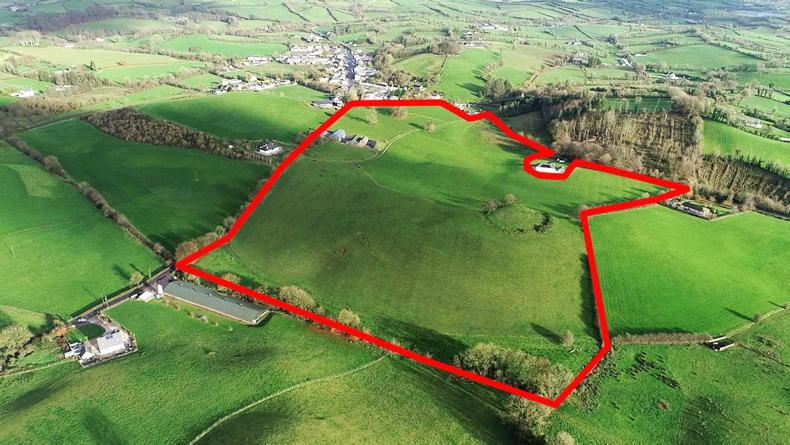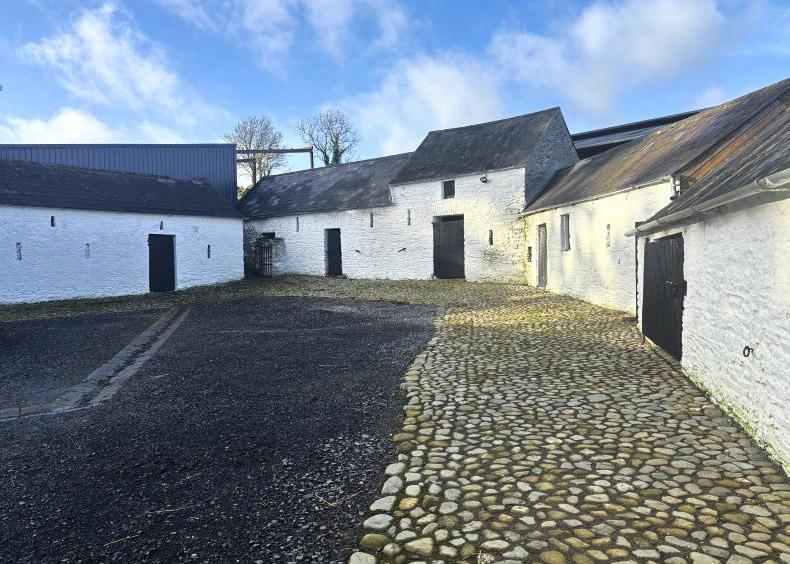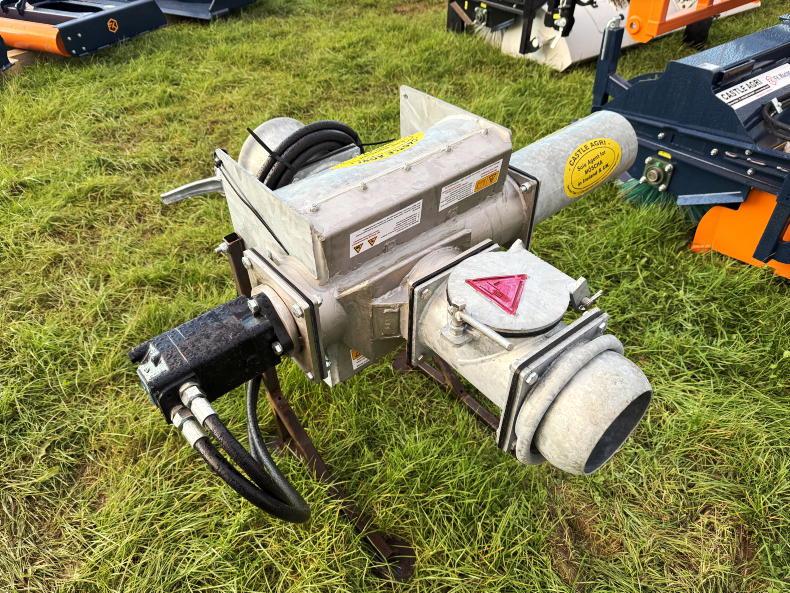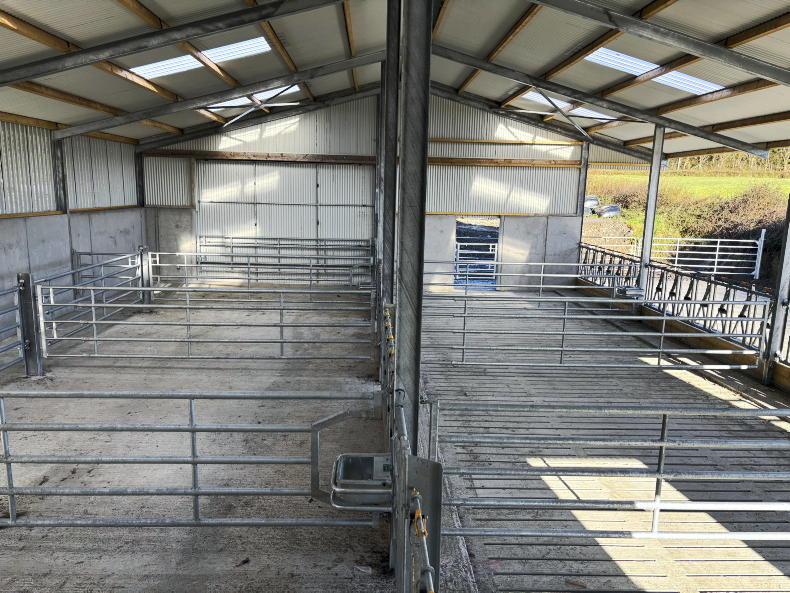Back in 2019, we visited the farm of Seamus and Jimmy Maloney outside Kilkelly, Co Mayo. The pair had recently completed a typical three-bay lean-to slatted shed with a creep area and crush to the back of the slats.
“Expansion was needed for a few years,’’ said Seamus. “Before the shed, the land base could hold more cattle than we could house so it was the pinch point.’’
Design and planning was completed by Carroll Consultants, Co Mayo.
The shed consists of three slatted pens towards the front, each 4.8m in length and 5.2m in width. A 4.4m slat was installed over a 4.1m wide tank which is 2.4m deep and has an internal length of 17.1m. At the back of the shed there are three 4.6m x 4.8m creep pens each with a crush fitted along the back wall. The feeding area to the front of the shed is covered by a 2.5m wide canopy. It is a typical suckler shed for the average beef farmer.
Cost in 2019
All work was completed in late 2018/early 2019 to TAMS specification. Seamus was entitled to the 60% grant rate being a qualified young farmer. The cost of the project came to €38,169.13 excluding VAT, with the farm family completing some work themselves. With the 60% grant rate, the net cost came to €15,267.60 or €5,089.20 per bay. Total TAMS grant aid received amounted to €22,901. Slats and stone were sourced from Harrington Quarries Ltd. The shed frame including all fixtures, sheeting, barriers and crush was supplied and fitted by Halcon Steel Ltd, with all concrete works completed by JMB Brett & Co.
Costs in 2022
There was a 52% increase between the 2018 and 2022 costs (see Table 2), while reference costs for the same period have only increased by 21% (see Table 1). The same suppliers and builder were used for the 2022 quotations, with a 10% inflation increase used for electrical and plumbing works.
If Seamus was to build the shed today, the figure is €5,119.57 above the TAMS reference cost, meaning he would be ineligible for grant aid on this €5,119.57. Of the remaining €53,091, if he were to receive a 60% grant, the cost to him would be €21,236.42, plus the €5,119.57 that was ineligible for a grant, with total net cost to Jimmy being €26,355.99, or €8,785.33 per bay. This figure is 72% higher than the price Jimmy paid for his shed in 2018/2019.
Halcon Steel Ltd said raw steel and labour were the main drivers of the price increase, with Harrington Quarries also stating that raw steel at €2,000/t was a major component in an increased slat price.
A sales representative said: “That price is for slats that were made last year. If we were to make them slats in the morning, the price would be even higher than that’.’
Increases in the price of concrete was the main reason for the concrete works price increase.
What suppliers are saying
Laurence Walsh of Cahir Steel and Agri, Tipperary said he isn’t “pricing a lot because there is no price to get”. He said the price of plate steel, a product which is made from components manufactured in Russia and Ukraine, is “off the Richter scale”.
George Doyle of Dunvale Fabricators, Edenderry, Co Offaly, described how this plate steel has gone from €1,000/t to €2,200/t in the space of a few weeks and warned that “this is only going one direction”. Similarly, he said raw steel has increased in price by €450/t since January alone.
A builder revealed that these prices have “put a stop to the whole thing” and that dairy farmers are “even stopping now”. He said that his business is “not taking in new orders now” as with rising fertiliser and feed costs, “the extra money is just not there” with farmers. Matthew Ryan of O’Dwyer Steel, Dundrum, Tipperary, said that while prices for steel had been going up since before the pandemic, some have kicked on by a further 20% since the start of the war in Ukraine. He said: “The farm work is definitely back this year by 50%. Beef and sheep farmers can’t afford it but there are a number of milking parlours going ahead.” Since February 2020, he said the cost of agricultural steel has increased by 70%, cladding by 100% and timber as much as 50%.
MJ Fox of Fox Bros Engineering, New Ross, Co Wexford, agreed with Ryan’s analysis. He said that “while this time of year would be quieter for farm buildings anyway”, there has been a drop off in activity. “By the time a farmer is done paying for fertiliser and meal, the sheds are on the back foot,” he said.
In short
This pre-pandemic-built shed offered good value for money when it was built, and allowed for a lack of housing to be addressed cost effectively. Even with a 60% TAMS grant, a 72% increase in the cost to the farmer is a stark figure. While the announcement last week of an increase on reference costs was welcomed to the industry, it will likely fall dramatically short of stabilising farm building prices.
Back in 2019, we visited the farm of Seamus and Jimmy Maloney outside Kilkelly, Co Mayo. The pair had recently completed a typical three-bay lean-to slatted shed with a creep area and crush to the back of the slats.
“Expansion was needed for a few years,’’ said Seamus. “Before the shed, the land base could hold more cattle than we could house so it was the pinch point.’’
Design and planning was completed by Carroll Consultants, Co Mayo.
The shed consists of three slatted pens towards the front, each 4.8m in length and 5.2m in width. A 4.4m slat was installed over a 4.1m wide tank which is 2.4m deep and has an internal length of 17.1m. At the back of the shed there are three 4.6m x 4.8m creep pens each with a crush fitted along the back wall. The feeding area to the front of the shed is covered by a 2.5m wide canopy. It is a typical suckler shed for the average beef farmer.
Cost in 2019
All work was completed in late 2018/early 2019 to TAMS specification. Seamus was entitled to the 60% grant rate being a qualified young farmer. The cost of the project came to €38,169.13 excluding VAT, with the farm family completing some work themselves. With the 60% grant rate, the net cost came to €15,267.60 or €5,089.20 per bay. Total TAMS grant aid received amounted to €22,901. Slats and stone were sourced from Harrington Quarries Ltd. The shed frame including all fixtures, sheeting, barriers and crush was supplied and fitted by Halcon Steel Ltd, with all concrete works completed by JMB Brett & Co.
Costs in 2022
There was a 52% increase between the 2018 and 2022 costs (see Table 2), while reference costs for the same period have only increased by 21% (see Table 1). The same suppliers and builder were used for the 2022 quotations, with a 10% inflation increase used for electrical and plumbing works.
If Seamus was to build the shed today, the figure is €5,119.57 above the TAMS reference cost, meaning he would be ineligible for grant aid on this €5,119.57. Of the remaining €53,091, if he were to receive a 60% grant, the cost to him would be €21,236.42, plus the €5,119.57 that was ineligible for a grant, with total net cost to Jimmy being €26,355.99, or €8,785.33 per bay. This figure is 72% higher than the price Jimmy paid for his shed in 2018/2019.
Halcon Steel Ltd said raw steel and labour were the main drivers of the price increase, with Harrington Quarries also stating that raw steel at €2,000/t was a major component in an increased slat price.
A sales representative said: “That price is for slats that were made last year. If we were to make them slats in the morning, the price would be even higher than that’.’
Increases in the price of concrete was the main reason for the concrete works price increase.
What suppliers are saying
Laurence Walsh of Cahir Steel and Agri, Tipperary said he isn’t “pricing a lot because there is no price to get”. He said the price of plate steel, a product which is made from components manufactured in Russia and Ukraine, is “off the Richter scale”.
George Doyle of Dunvale Fabricators, Edenderry, Co Offaly, described how this plate steel has gone from €1,000/t to €2,200/t in the space of a few weeks and warned that “this is only going one direction”. Similarly, he said raw steel has increased in price by €450/t since January alone.
A builder revealed that these prices have “put a stop to the whole thing” and that dairy farmers are “even stopping now”. He said that his business is “not taking in new orders now” as with rising fertiliser and feed costs, “the extra money is just not there” with farmers. Matthew Ryan of O’Dwyer Steel, Dundrum, Tipperary, said that while prices for steel had been going up since before the pandemic, some have kicked on by a further 20% since the start of the war in Ukraine. He said: “The farm work is definitely back this year by 50%. Beef and sheep farmers can’t afford it but there are a number of milking parlours going ahead.” Since February 2020, he said the cost of agricultural steel has increased by 70%, cladding by 100% and timber as much as 50%.
MJ Fox of Fox Bros Engineering, New Ross, Co Wexford, agreed with Ryan’s analysis. He said that “while this time of year would be quieter for farm buildings anyway”, there has been a drop off in activity. “By the time a farmer is done paying for fertiliser and meal, the sheds are on the back foot,” he said.
In short
This pre-pandemic-built shed offered good value for money when it was built, and allowed for a lack of housing to be addressed cost effectively. Even with a 60% TAMS grant, a 72% increase in the cost to the farmer is a stark figure. While the announcement last week of an increase on reference costs was welcomed to the industry, it will likely fall dramatically short of stabilising farm building prices. 









SHARING OPTIONS